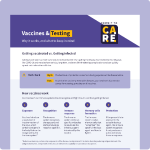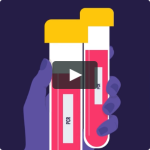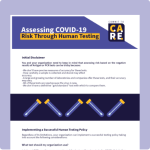Vaccination and testing tools
Science-based vaccination and testing tools to help protect the health and safety of workers from infectious diseases of today and tomorrow

Getting vaccinated vs. Getting infected
Getting vaccinated is a much safer way to build protection than getting the disease itself.
Airborne viral diseases like COVID-19 and measles have serious, long-term, and even life-threatening complications and can quickly spread and make others sick too.
How do vaccines work?
01
Exposure
Vaccines introduce a harmless part or a weakened or inactivated version of a virus into the body.
02
Recognition
The immune system recognizes the exposure and starts producing a response against it.
03
Inmune response
The immune system produces specific antibodies to neutralize the infectious agent introduced by the vaccine.
04
Memory cells formation
The immune system creates memory cells that “remember” the specific infectious agent and how to fight it.
05
Protection
If the person is later exposed to the actual infectious agent, the immune system recognizes it and produces a quick and robust immune response.

Fact Check
Getting a vaccine does not mean you will not be infected if exposed. However, in some cases, vaccines protect people from getting seriously ill, being hospitalized, and dying.
Vaccine side effects
You might experience side effects after your vaccine, which is a normal sign that your body is building up its protection. The most common symptoms are:
A sore or swollen arm
Tiredness
Headache
Fever
Chills
The risk of not getting vaccinated
Higher amount of non-vaccinated people infected with an airborne virus

Higher:
- Risk of transmitting it to others.
- Causing breakthrough infections in those vaccinated.
A workforce with a large population of non-vaccinated can pose a risk to the communities in which they work and increase:

Lack of productivity
Unvaccinated employees must quarantine for 14 days after an exposure, while vaccinated employees face no such quarantine requirement.

Long-term illnesses
Those who get COVID-19 without being vaccinated could have long-term disabilities from long COVID-19. Some might need workplace accommodations, while others might not be able to return to the workforce.
Absenteeism
Employees, customers and clients might be more wary about coming to a workplace with lower rates of employee vaccination.
Let’s talk about COVID-19 testing
Testing immediately when presenting COVID-19-like symptoms helps confirm if you have it and reduces the chances of putting the health and safety of those around you at risk.

Types of COVID-19 tests
PCR-based tests:
These tests are performed in a laboratory and are the most reliable test for people with or without symptoms. These tests detect viral genetic material, which may stay in your body for up to 90 days after you test positive.
PCR-based tests:
These tests generate results in 15-30 minutes. Remember that positive self-test results are highly reliable but that a single antigen test negative result does not rule out infection, especially if you have symptoms.
Remember…

If you test positive, the CDC encourages individuals to report the result to their healthcare provider and any recent or close contacts so that they can keep themselves and those around them safe.

If you are in a high-risk setting or around vulnerable populations, consistent testing as part of a screening program can help protect those around you from unintentional infection.

Follow quarantine guidelines as mandated by your employer or state health department guidelines.






